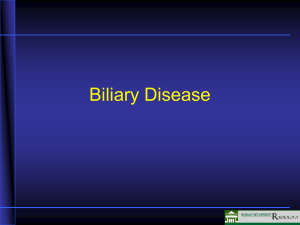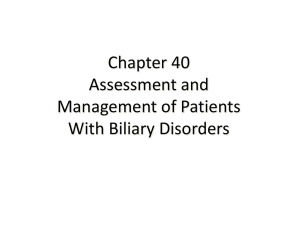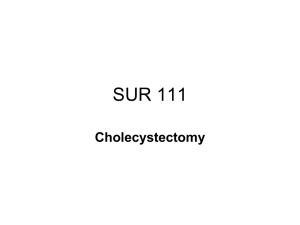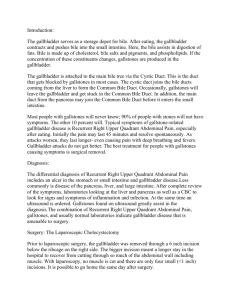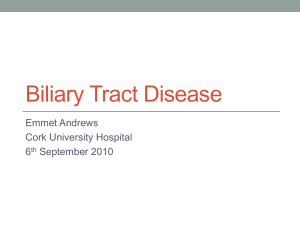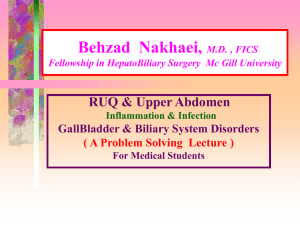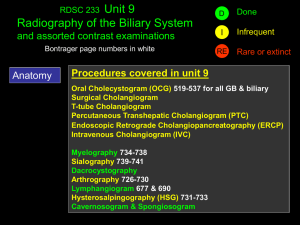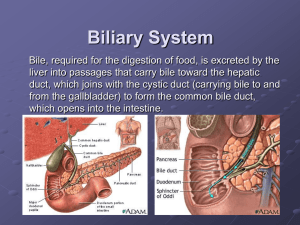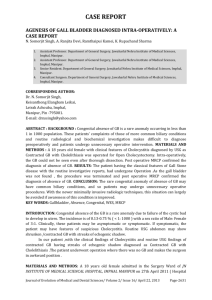Gallbladder Disease
advertisement
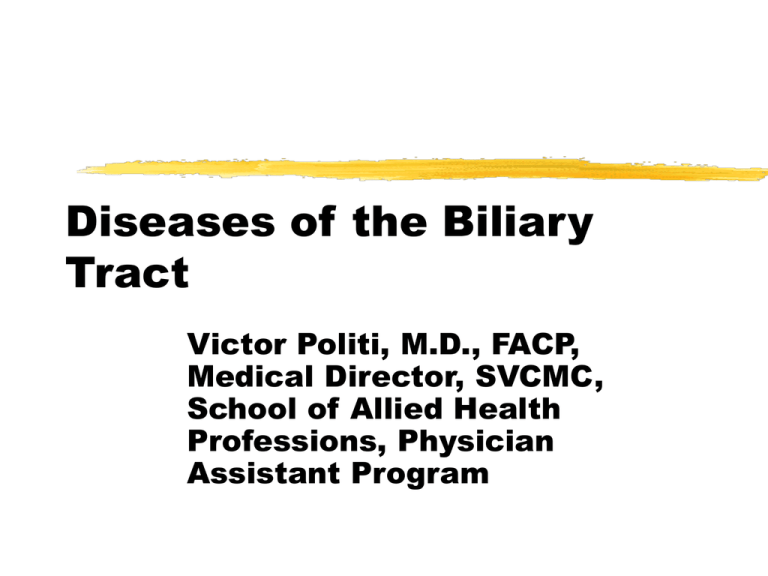
Diseases of the Biliary Tract Victor Politi, M.D., FACP, Medical Director, SVCMC, School of Allied Health Professions, Physician Assistant Program Cholelithiasis (Gallstones) Cholelithiasis (Gallstones) Gallstone disease, or cholelithiasis, is one of the most common surgical problems worldwide. Gallstones are abnormal, inorganic masses formed in the gallbladder and, less commonly, in the common bile or hepatic ducts They are a frequent cause of abdominal pain and dyspepsia. Although gallstones can form anywhere in the biliary tree, the most common point of origin is within the gallbladder. Three types of gallstones exist: pure cholesterol pure pigment mixed Gallstones are classified according to their predominant chemical composition as either: cholesterol calcium bilirubinate stones < 20% of stone type in Europe & US 30-40% of stones in Japan Three compounds comprise 80-95% of the total solids dissolved in bile; conjugated bile slats lecithin cholesterol Under normal conditions, a delicate balance occurs among the levels of bile acids, cholesterol, and phospholipids. A disparity in this balance, especially with the supersaturation of cholesterol, predisposes patients to the formation of lithogenic bile and the subsequent development of cholesterol-type gallstones. Pigmented gallstones are composed of calcium bilirubinate and appear in 2 major forms: black and brown. Hemolysis and liver disease are associated with the black stones; the brown, earthy stones more frequently are formed outside the gallbladder and often are associated with bacterial infections of the biliary tract. Mortality / Morbidity Related directly to the complications of the disease and its surgical treatment Approximately 10% patients with gallstones have common bile duct stones Gallstones can cause obstruction of the common bile duct, causing jaundice Cholangitis, a potentially life-threatening infection, can follow biliary obstruction Mortality / Morbidity Obstruction of the neck of the gallbladder causes bile stasis, which can lead to inflammation and edema of the gallbladder wall. Sequelae of this condition include acute cholecystitis secondary to compromised lymphatic, venous, and, ultimately, arterial supply to the gallbladder. The latter can lead to gangrene or abscess formation. Women are more likely to develop gallstones than men, with a ratio of 2:1. Classically, gallstones occur in obese, middle-aged women, which leads to the popular mnemonic, fat fertile forties. History Nausea, with or without vomiting, might be present. Certain foods, especially those with high fat content, can provoke symptoms. The patient might experience episodes of acute abdominal pain, called biliary colic. Physical Murphy sign pain on palpation of the right upper quadrant when the patient inhales might indicate acute cholecystitis Other signs of cholecystitis fever tachycardia Complications of cholelithiasis The physical examination might indicate complications of cholelithiasis. Passage of gallstones from the gallbladder into the common bile duct can result in a complete or partial obstruction of the common bile duct. Frequently, this manifests as jaundice. In all races, jaundice is detected most reliably by examination of the sclera in natural for yellow discoloration. Complications of cholelithiasis Pancreatitis, another complication of gallstone disease, presents with more diffuse abdominal pain, including pain in the epigastrium and left upper quadrant of the abdomen. Complications of cholelithiasis Severe hemorrhagic pancreatitis occurs in 15% patients and carries a high mortality rate because of multisystem organ failure. In a few patients, the hemorrhagic pancreatic process and retroperitoneal bleeding induce discoloration around the umbilicus (Cullen sign) or the flank (GreyTurner sign). Complications of cholelithiasis Charcot triad (right upper quadrant pain, fever, and jaundice) associated with common bile duct obstruction and cholangitis Additional symptoms: alterations in mental status and hypotension, indicate Raynaud pentad, a harbinger of worsening, ascending cholangitis. Causes of cholelithiasis Prolonged fasting (5-10 days) can result in the formation of biliary sludge (microlithiasis) which resolves by itself when feeding is reestablished - but it can lead to biliary symptoms or gallstone formation Lab Studies For patients with uncomplicated cholelithiasis, blood work results usually are normal. However, labs can detect complications of gallstone disease; complications might alter the course of treatment. Lab Studies CBC chemistry panel, including electrolytes, liver enzymes, and bilirubin. Choledocholithiasis can manifest with only elevation of serum alkaline phosphatase or bilirubin. Nearly 50% of patients with symptomatic gallstone disease will have abnormal transaminases Lab Studies Serum lipase and amylase levels are helpful in cases of diagnostic uncertainty or suspected concurrent pancreatitis Imaging Studies X-rays Approximately 15% of gallstones are radiopaque and can be visualized on plain x-ray. A porcelain gallbladder (heavily calcified) should be removed surgically because of increased risk of gallbladder cancer. Other causes of abdominal pain diagnosed with the assistance of x-rays include perforated viscus, bowel obstruction, calcific pancreatitis, and renal stones. Imaging Studies Ultrasound (US) is the most sensitive and specific test for the detection of gallstones. US provides information about the size of the common bile duct and hepatic duct and the status of liver parenchyma and the pancreas. Thickening of the gallbladder wall and the presence of pericholecystic fluid are radiographic signs of acute cholecystitis Imaging Studies CT scanning often is used in workup of abdominal pain without specific localizing signs or symptoms. CT scanning is not a first-line study for detection of gallstones because of greater cost and the invasive nature of the test. When present, gallstones usually are observed on CT scan. Imaging Studies HIDA scan does not detect gallstones HIDA scan identifies an obstructed gallbladder (eg, gallstone impacted in the neck of the gallbladder). HIDA scan is the most sensitive and specific test for acute cholecystitis. A poorly contracting gallbladder (biliary dyskinesia) might cause the patient's symptoms, and HIDA scan makes the diagnosis. Acute acalculous cholecystitis is diagnosed most accurately with HIDA scan. Treatment Removal of the gallbladder laparoscopic cholecystectomy is the treatment of choice for symptomatic gallbladder disease Only gallstones that cause symptoms or complications require treatment Treatment There is generally no reason for prophylactic cholecystectomy in an asymptomatic person unless the gallbladder is calcified gallstones are > 3cm in diameter Acute Cholecystitis Acute Cholecystitis Cholecystitis is associated with gallstones in > 90% of cases Inflammation develops behind a stone impacted in the cystic duct May be caused by infectious agents (cytomegalovirus, cryptosporidiosis, or microsporidiosis) common in AIDS patients Acalculous cholecystitis should be considered in patient with FUO, RUQ pain occurring 2-4 weeks after major surgery History Acute attack often follows a large, fatty meal sudden, steady pain in epigastrium or right hypochondrium - pain may steadily subside over a period of 12-18 hours vomiting - 75% Of cases RUQ tenderness associated with muscle guarding and rebound pain History Palpable gallbladder 15% of cases Jaundice 25% of cases also suggestive of choledocholithiasis Fever Labs WBC - elevated (12-15,000 usuallly) Total serum bilirubin 1-4mg/dL Often elevated levels of: serum aminotransferase alkaline phosphatase serum amylase Imaging Studies X-ray may show radiopaque gallstones 15% of cases HIDA Scan useful for obstructed cystic duct reliable if bilirubin < 5mg/dL Ultrasound useful for gallstone visulization Other Conditions Some disorders that may be confused with acute cholecystitis: perforated peptic ulcer acute pancreatitis appendicitis (high lying appendix) liver abscess hepatitis pneumonia w/pleurisy on right side myocardial ischemia The localization of pain and tenderness in the right hypochondrium with radiation to the infrascapular area strongly favors the diagnosis of acute cholecystitis Treatment Conservative tx regimen of TPN analgesics (Meperidine preferred drug- less spasm of sphincter of Oddi) antibiotics Treatment Due to high rate of recurrence cholecystectomy advised cholecystectomy must be performed when evidence of gangrene or perforation is present Choledocholithiasis & Cholangitis Choledocholithiasis Choledocholithiasis - common bile duct stones Occur in 15% of patients with gallstones Increases with age - in elderly w/gallstones occurrence as high as 50% Usually condition goes unknown until obstruction occurs History History suggestive of biliary colic or jaudice frequent/recurrent attacks of severe RUQ pain- duration of several hours severe colic - chills/fever History Charcot’s Triad- classic picture of cholangitis Pain Fever Chills Imaging The most direct and accurate way to determine the cause, location, and extent of obstruction: ERCP percutaneous transhepatic cholangiography Treatment Common duct stone in patient with cholelithiasis and cholecystitis is usually treated with endoscopic papillotomy and stone extraction - followed by laparoscopic cholcystectomy Treatment Ciprofloxacin, 250mg IV q 12 hours effective tx for cholangitis alternative tx - mezlocillin, 3g IV q 4 hours with either metronidazole or gentamicin or both Aminoglycosides should not be used for more than several days due to increased risk of aminoglycoside nephrotoxicity in cholestasis Primary Sclerosing Cholangitis Rare disorder Characterized by diffuse inflammation of the biliary tract leading to fibrosis and strictures of the biliary system Most common - men aged 20-40 Primary Sclerosing Cholangitis Associated with histocompatible antigens HLA-B8 and -DR3 or -DR4 - suggestive of genetic etiologic role Sclerosing cholangitis may occur in AIDs patients from infections caused by CMV, cryptosporidium, or microsporum Primary Sclerosing Cholangitis Symptoms progressive obstructive jaundice frequently associated with: malaise, pruritus,anorexia and indigestion Early detection in presymptomatic phase may occur due to elevated alkaline phosphatase level Primary Sclerosing Cholangitis Complications of chronic cholestasis such as osteoporosis and malabsorption of fatsoluble vitamins may occur Diagnosis generally made by: ERCP magnetic resonance cholangiography Primary Sclerosing Cholangitis Tx w/corticosteroids and broad spectrum antimicrobial agents yields inconsistent and unpredictable results Episodes of acute bacterial cholangitis may be treated with ciprofloxacin high dose ursodeoxycholic acid (20mg/kg/d) may reduce cholangiographic progression and liver fibrosis Primary Sclerosing Cholangitis In patients with ulcerative colitis, primary sclerosing cholangitis is an independent risk factor for development of colorectal dysplasia and cancer- routine colonoscopic surveillance is advised Primary Sclerosing Cholangitis For patients with cirrhosis and clinical decompensation, liver transplantation is the procedure of choice Primary Sclerosing Cholangitis Survival of patients with primary sclerosing cholangitis averages 10 years once symptoms appear Adverse prognostic factors: increased age increased serum bilirubin increased aspartate aminotransferase levels low albumin levels history of variceal bleeding Carcinoma of the biliary tract Carcinoma of Biliary Tract Occurs in 2% of people surgically treated for biliary disease Insidious onset - usually discovered during surgery Cholelithiasis usually present Carcinoma of Biliary Tract Other risk factors: Chronic gallbladder infectionwith salmonella typhi gallbladder polyps over 1cm mucosal calcification of the gallbladder (porcelain gallbladder) anomalous pancreaticobiliary ductal junction Carcinoma of Biliary Tract Carcinoma of the bile ducts (cholangiocarcinoma) accounts for 3% of all US cancer deaths Effects both sexes equally More prevalent 50-70 age group Carcinoma of Biliary Tract 2/3 Klatskin tumors - arise at the confluence of hepatic ducts 1/4 in the distal extrahepatic bile duct remainder are intrahepatic Carcinoma of Biliary Tract Signs/symptoms: Progressive jaundice pain RUQ w/ pain radiating to back present in gallbladder CA but occurs later in course of bile duct carcinoma anorexia, weight loss fever, chills (due to cholangitis) Carcinoma of Biliary Tract A palpable gallbladder w/obstructive jaundice usually is said to signify malignant disease (Courvoisier’s Law): however this has only proved to be accurate 50% of the time Hepatomegaly, liver tenderness Pruritus Labs Conjugated hyperbilirubinemia elevated alkaline phophatase elevated serum cholesterol AST may be slightly elevated CA19-9 (elevated level can help distinguish cholangiocarcinoma from benign biliary stricture) Imaging Studies Ultrasound CT MRI MRCP Treatment Laparoscopic cholecystectomy 5 year survival for localized carcinoma of the gallbladder is as high as 80% survival rates drop dramatically with more extensive disease Carcinoma of the bile ducts is curable by surgery in < 10% of cases Questions ?
